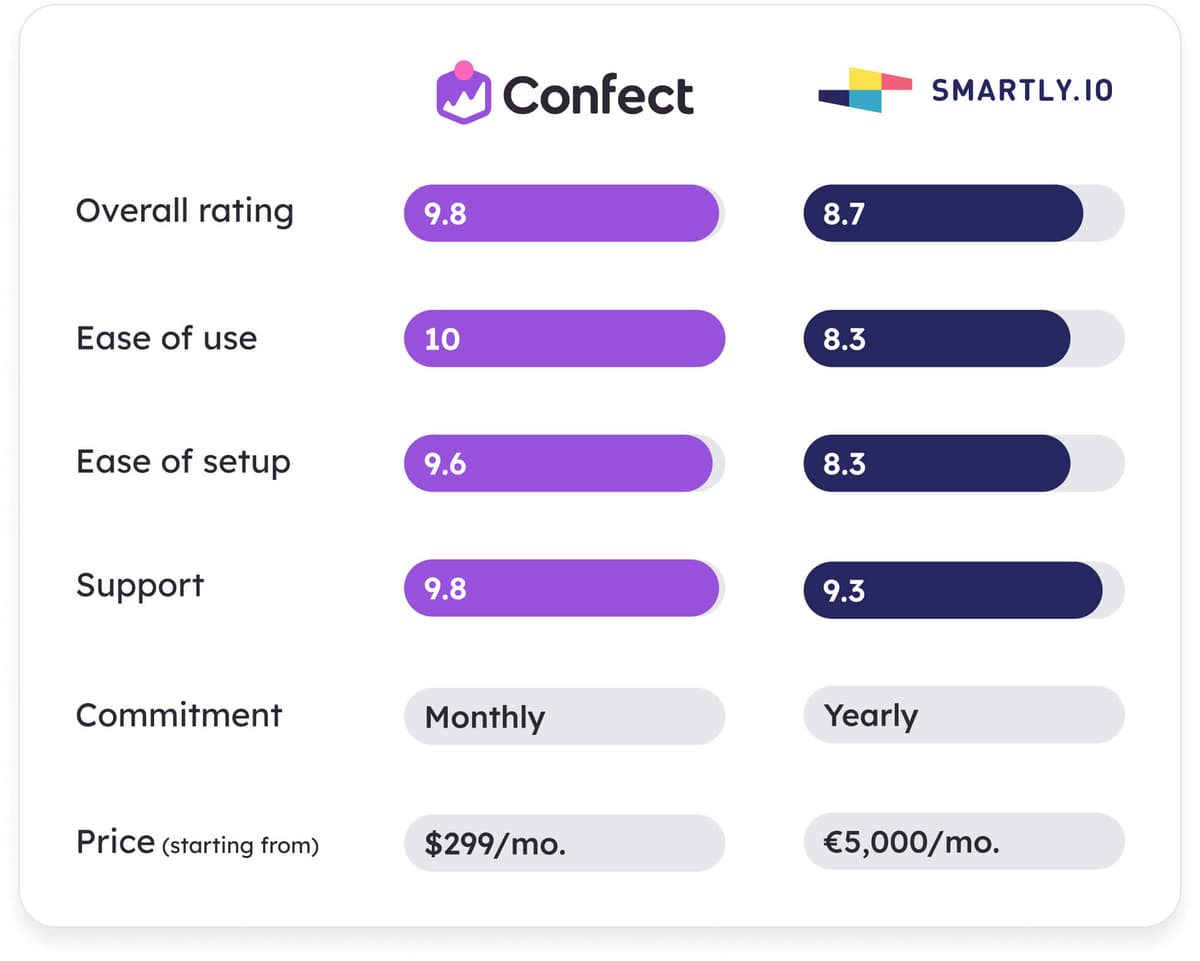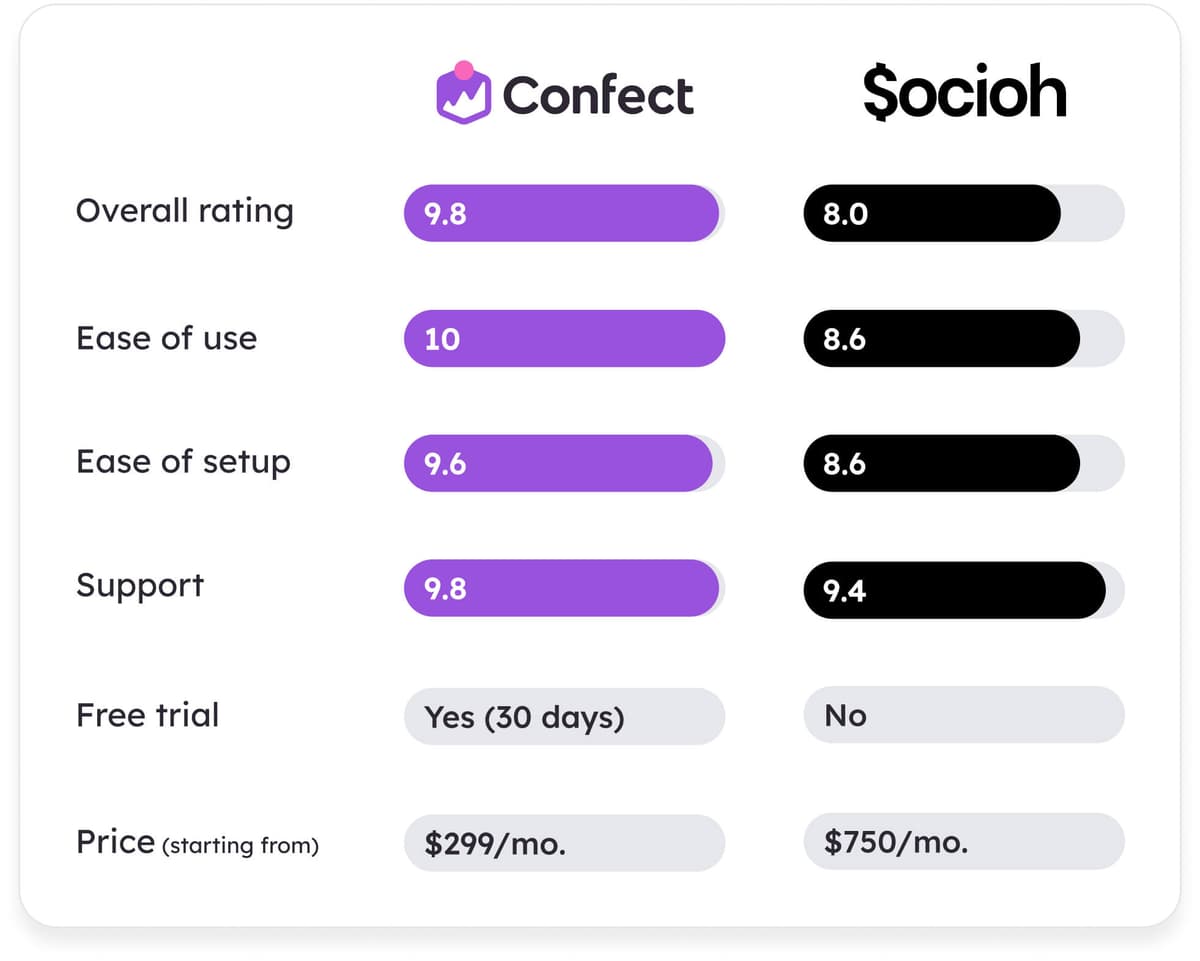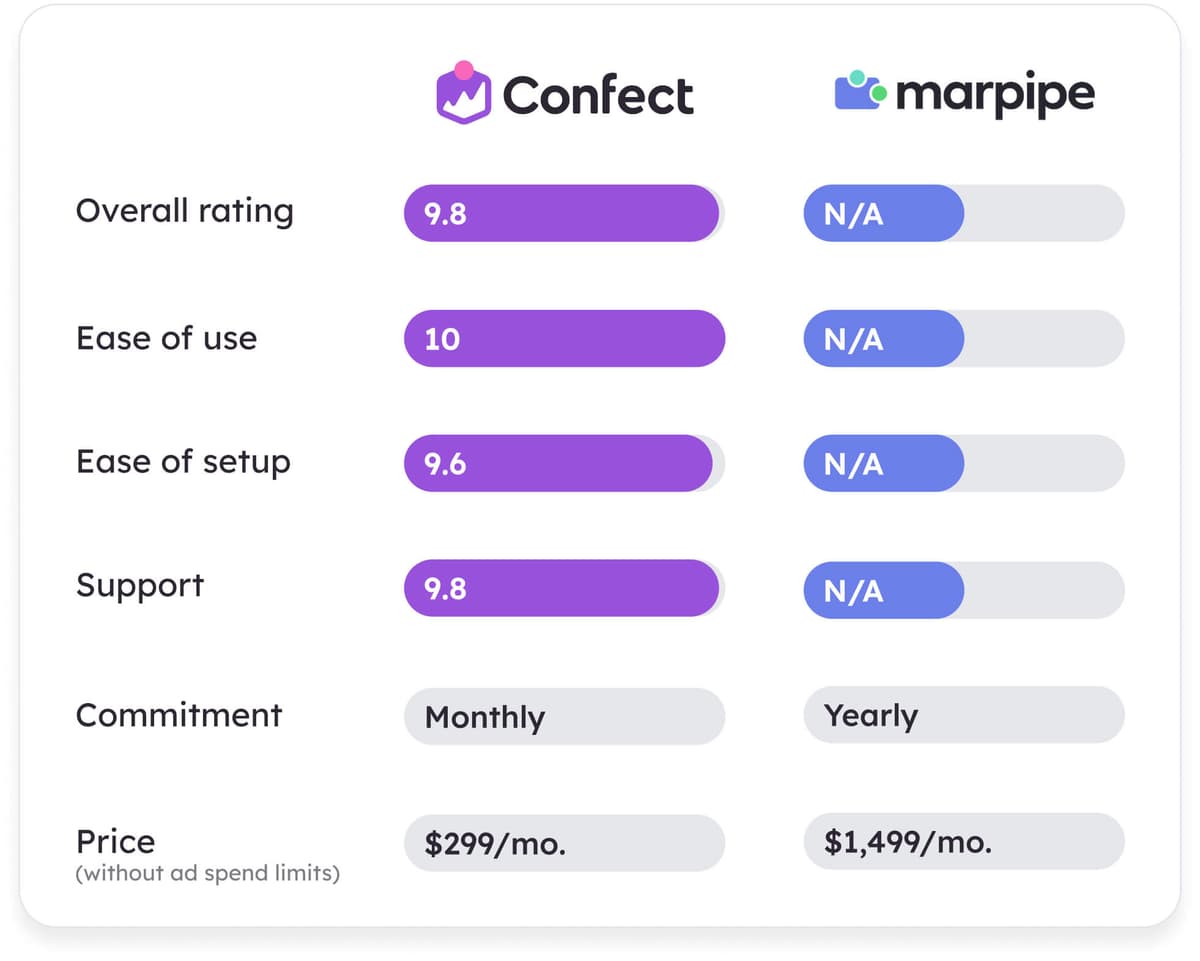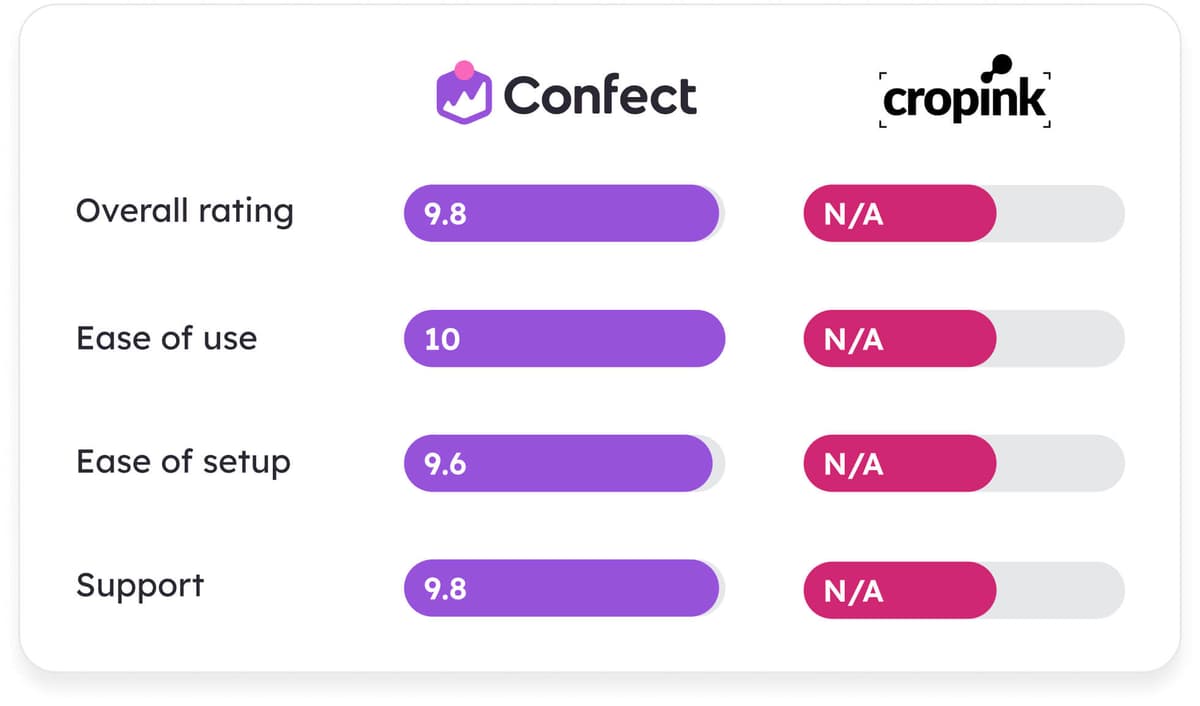Compare Confect against the alternatives
Confect is used by the leading ecommerce companies








G2 ratings of Paid Social automation tools
Paid social tools do everything. Confect just does Catalog Ads - but does them better.

Confect vs Smartly
Confect or Smartly? For many eCommerce marketers, that’s the first big choice when scaling Catalog Ads on Meta.
Smartly has an overall rating of 8.7 on G2 from its customers, with support being the best-rated area with 9.3, and ease of use being rated 8.3 out of 10.

Confect vs Hunch
If Meta Catalog Ads are key to your paid social strategy, this guide makes the decision between Hunch and Confect much easier. Both tools are powerful, but built for different types of teams.
Hunch has an overall rating of 9.2 on G2 from its customers, with support being the best-rated area with 9.9, and ease of use being rated 8.3 out of 10.

Confect vs ROI Hunter
ROI Hunter and Confect both support Catalog Ads on Meta, but the overlap mostly ends there. One is built for product management, the other for Catalog Ads specifically.
ROI Hunter has an overall rating of 9.6 on G2 from its customers, with support being the best-rated area with 9.8, and ease of use being rated 8.8 out of 10.
Compare Confect to Paid Social automation alternatives
While Paid Social Automation tools aim to do everything; campaign creation, targeting, bidding, cross-platform rollout - Confect does one thing exceptionally well: Catalog Ads. That singular focus is what sets us apart.
Where automation platforms like Smartly, Hunch, or ROI Hunter offer a broad set of features for managing all your paid social campaigns outside of Facebook Ads Manager, Confect integrates directly into it. There’s no need to relearn a new ecosystem, rebuild your ad structures, or move your team into a new tool. You stay in control, and you stay inside the platform you already use.
The trade-off with these enterprise platforms focusing on all aspects of Paid Social? These automation platforms are expensive, often starting at $2,000–$5,000 per month. And while they promise full-stack automation, they come with steep learning curves, UI bugs, sync delays, and weak catalog-specific features. If your main focus is making high-performing, on-brand Catalog Ads - not automating your entire ads operation - this complexity is unnecessary.
Confect is lean, visual, and built specifically for marketers who care about creative performance in Dynamic Product Ads. It’s faster to set up, easier to use, and priced more accessibly. We support features Paid Social platforms often overlook or complicate, like creative variants, story formats, and video catalog ads - because we know these nuances drive real performance.
If you’re spending heavily on Catalog Ads and want to make them stand out with minimal friction, Confect is the tool designed for that mission alone. It's not a “do-it-all” platform - it's a “do-this-better-than-anyone” platform.
G2 ratings of Catalog Ads tools
Overlays and templates? Every tool has them. Confect does much, much more.

Confect vs Socioh
On paper, Socioh and Confect look similar - but when you look at advanced features, pricing flexibility, and creative control, they are very different.
Socioh has an overall rating of 8.0 on G2 from its customers, with support being the best-rated area with 9.4, and ease of use being rated 8.6 out of 10.

Confect vs Marpipe
Both Marpipe and Confect are made for eCommerce brands running Catalog Ads. Pricing, ease of use, and platform focus are where the two really diverge.
As of May 2025, Marpipe doesn't have enough customer reviews on either G2 (4 reviews) or Capterra (1 review) for the platforms to generate ratings for Marpipe.

Confect vs Cropink
Cropink is a lightweight tool for basic Catalog Ad design. Confect is a full creative platform that gives eCommerce teams more power over every ad variation and format.
As of May 2025, Cropink doesn't have enough customer reviews on either G2 (0 reviews) or Capterra (0 reviews) for the platforms to generate ratings for Cropink.

Confect vs Genus AI
Looking at Genus AI and Confect for Catalog Ads?
As of May 2025, Genus AI doesn't have enough customer reviews on either G2 (0 reviews) or Capterra (0 reviews) for the platforms to generate ratings for Genus AI.
Compare Confect to other Catalog Ads design alternatives
Most Catalog Ads design tools offer the basics: product overlays, templates, maybe even a few dynamic elements. But Confect was the first tool built specifically for Catalog Ads - and it still leads the category in depth, flexibility, and performance.
Other tools like Marpipe, Socioh, or Genus AI might promise similar outcomes, but they often fall short when it comes to advanced features or creative control. Many of them are built as add-ons to larger platforms, not as standalone solutions for serious ecommerce advertisers. That means limited support for video formats, restricted design automation, or clunky workflows when trying to run multiple creative variants at once.
Confect, on the other hand, was designed from the ground up to empower paid social specialists. You can run multiple creative variants at scale, schedule design changes around key campaigns like Black Friday, and build formats that actually perform on Meta - like video DPAs, 9:16 story placements, or mobile-optimized 4:5 formats. Most other tools don’t even support these.
And while others may try to win deals with flashy websites or aggressive sales tactics (often claiming to be “10x better” than one another), we keep it simple: try Confect for 30 minutes, and you’ll see the difference immediately. Faster workflows. More creative control. Better Catalog Ads.
If you’re serious about growing through Catalog Ads, not just checking the box, Confect gives you the power to do it better, faster, and with less friction. We don't just support Catalog Ads. We specialize in them.
Ready to try Confect?
It's easy to try out Confect and see how it could look and perform with your products and brand identity.
Compare Confect to Feed Management Tools alternatives
Feed management tools like Channable, DataFeedWatch, or Productsup are great at what they’re built for: organizing and optimizing product data across platforms like Google, Facebook, and Amazon. They make sure your catalog is technically sound and formatted correctly. But when it comes to actually designing high-performing Catalog Ads, that’s where they fall short.
Most feed tools include a basic image editor, but it’s usually clunky, limited, and built as an afterthought. Design changes are rare - often done once a year (if that) - because the tools are too technical for designers and too tedious for marketers. You can’t run multiple variants or support modern ad formats like video or story placements.
That’s where Confect comes in.
Confect doesn’t touch your product feed. Instead, it builds on top of it to create scroll-stopping Catalog Ads that perform on platforms like Meta, Pinterest, and Snapchat. Our entire platform is built for design and performance so you can run multiple creative versions, adapt to different placements, schedule design changes, and create video and vertical formats that convert.
If your budget for Catalog Ads is over $3,000/month, feed tools will leave performance on the table. Confect gives you the creative power to unlock that potential.
In short: Feed tools make your catalog functional. Confect makes it perform. If you’re aiming for more than “good enough,” and want to actually drive results with your ads, Confect is the tool that turns your feed into revenue.
Compare Confect to Display Banner alternatives
Display banner tools like Celtra, Bannerwise, or Creatopy are designed to create static and animated banners for web placements. Some have adapted their platforms to include product feed support - but Catalog Ads are not their core focus. For eCommerce marketers who want high-performing Dynamic Product Ads on Meta, that’s a major limitation.
Confect is fundamentally different. Where display banner platforms try to “bolt on” product functionality through XML or CSV feeds, Confect is built natively around products and catalogs. Everything from the interface to the automation is tailored for dynamic, product-driven ads; no workarounds, no compromises.
The result? With Confect, you can easily run multiple design variants, use product-specific conditions, and create scroll-stopping formats like 9:16 story placements or 4:5 video catalog ads. These formats are either unsupported or extremely difficult to build with display banner tools.
Display tools might be a good fit if your designers are already deeply invested in them for web banners, but they come with trade-offs. You won’t get multiple design variants, or native Meta ad formatting for 9:16 or videos. And performance will likely suffer.
If you’re running Catalog Ads as a core part of your paid social strategy, Confect will give you significantly more creative flexibility and better results. It’s easier for marketers to use, better for product-level personalization, and built specifically to convert in Meta’s dynamic ad ecosystem.
In short: Display tools are generalists. Confect is a specialist. And in Catalog Ads, specialization wins.
